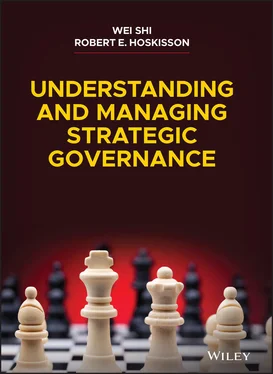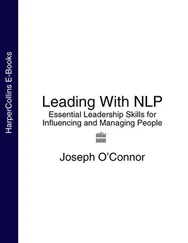Robert E. Hoskissonis the George R. Brown Emeritus Chair of Strategic Management at the Jesse H. Jones Graduate School of Business, Rice University. He received his PhD from the University of California–Irvine. His research topics focus on corporate governance, acquisitions and divestitures, corporate and international diversification, and cooperative strategy. He has taught courses in corporate and international strategic management, cooperative strategy, and strategy consulting. He has co-authored over 30 books, including recent books on business strategy and competitive advantage. Dr. Hoskisson has served on several editorial boards for such publications as the Strategic Management Journal (associate editor), Academy of Management Journal (consulting editor), Journal of International Business Studies (consulting editor), Journal of Management (associate editor), and Organization Science . His research has appeared in over 130 publications, including the Strategic Management Journal , Academy of Management Journal , Academy of Management Review , Organization Science , Journal of Management , Academy of Management Perspective , Academy of Management Executive , Journal of Management Studies , Journal of International Business Studies , Journal of Business Venturing , Entrepreneurship Theory and Practice , California Management Review, and Journal of World Business . Dr. Hoskisson is a fellow of the Academy of Management and also a fellow of the Strategic Management Society. He was a representative-at-large on the board of governors of the Academy of Management for three years. He also served as president of the Strategic Management Society and served on its executive committee for 6 years and on its board of directors for a total of 12 years.
CHAPTER 1 Introduction to Strategic Governance and Internal Governance Actors
BOX 1.1Strategic Governance Challenge: Chaos in the Board Room
According to a recent survey of 341 chief marketing officers, chief marketing officers (CMOs) spend 68.5 percent of their time “managing the present” and only 31.5 percent “preparing for the future.” The survey took place before the COVID-19 pandemic, making it especially telling since strategic marketing is meant to focus on developing initiatives that help build future competitiveness. This type of short-termism, research suggests, has been a rising trend among top management teams for decades. Executives, after all, must increasingly contend with pressures from performance-oriented governance actors such as activist shareholders when making strategic decisions. Some researchers, however, do not consider this trend problematic, asserting that company executives must manage firms for long-term value creation and short-term performance. Under this view, corporate leaders who avoid these twin imperatives do so at their peril.
While boards of directors are duly bound to act with care and loyalty and without conflicting interests for the benefit of shareholders, activist owners among the shareholders pursue returns without necessarily regarding long-term strategic visions, often playing a powerful role in short-termism.
One recommendation for short-termism includes “reward long-term investors” by creating more tiers for tax breaks for long-term investors because the current taxing system rewards trading securities rather than owning companies for the long term. Board members may also align executive compensation with long-term results to motivate them to carry out visions for the long run. These proposals typically try to address governance challenges due to activist shareholders steadily gaining influence on corporate strategic decisions, often forcing election of their board candidates to provide direct inputs into major strategic decisions.
In March 2020, for example, activist hedge fund Impala Asset Management LLC filed documents nominating two directors to Harley-Davidson's board. Impala investors also called for replacing then-CEO Matthew Levatich, who had shifted the firm's marketing focus to a more diverse customer base with Harley's “More Roads” campaign, away from its traditional base of 35- to 60-year-old Americans who buy expensive motorcycles. While Harley holds approximately 50 percent of the US market share in this segment, in recent years the company had been losing sales to bikes produced by BMW, Ducati, and Triumph. According to Impala, the management change was “needed because the current board wasn't proactive enough to address the poor performance,” noting that, in 2019, Harley Davidson underperformed its peers and missed its unit shipping guidance for a fifth year in a row, even while Levatich's pay had been raised to more than $11 million, a figure higher than any he had been paid since taking over in 2015. In February 2020, a new CEO, Jochen Zeitz, was abruptly put in place due in part to the pressure of Impala as Levatich stepped down, and Zeitz is refocusing Harley on its traditional business.
In addition to pressuring for reshuffled management, activist shareholders may also use what are known as “wolf pack” strategies. Hedge fund activists team up to foster a common agenda, often forcing firm leaders to boost short-term performance at the expense of the interests of long-term investors and other stakeholders. Such pressures have a compounding effect. One director notes: “From dealing with multiple crises, to being sued, to orchestrating spinoffs, buyouts, and mergers, to dealing with activists, these all bring their own set of challenges.” The director makes the point that tough issues, once outlier events, have become commonplace as company leaders come under an increasingly “hot spotlight” from multiple stakeholders, forcing directors to answer more quickly and proactively.
We have written this book to enable practitioners to navigate the new, ever-more challenging governance environment. Managers and board members urgently need up-to-date, sophisticated comprehension on what we call strategic governance: the tools and orientation to fully understand and then manage the increasingly chaotic world of corporate governance and strategic decision-making.
Sources: Campbell, P. (2020). Managing tough issues in the boardroom. https://boardmember.com/managing-tough-issues-in-the-boardroom/, accessed July 13, 2020; Coppola, G., & Weiss, R. (2020). Harley-Davidson gets an unlikely rider. Bloomberg Businessweek , July 27, 8–10; Sampson, R. C., & Shi, Y. (2020). Are US firms becoming more short-term oriented? Evidence of shifting firm time horizons from implied discount rates, 1980–2013, Strategic Management Journal , forthcoming; Welch, D., Deveau, S., & Coppola, G. (2020). Activist battling Harley's board urges focus on core riders. Bloomberg , www.bloomberg.com, March 20; Christie, A. L. (2019). The new hedge fund activism: Activist directors and the market for corporate quasi-control. Journal of Corporate Law Studies 19 (1): 1–41; Moorman, C., & Kirby, L. (2019). How marketers can overcome short-termism. Harvard Business Review Digital Articles , www.hbs.com, 2–5; Thomas, L. (2019). Stop panicking about corporate short-termism. Harvard Business Review Digital Articles , www.hbs.com, 2–4; Porter, M.E. (1992). Capital disadvantage: America's failing capital investment system. Harvard Business Review 70 (5): 65–82.
How many corporate governance teams are equipped to face the strategic challenges spurred by the cross currents within the contemporary activist environment? Authentic strategic governance must go beyond simply making a set of decisions in response to a specific issue, and move toward a comprehensive approach for dealing with activist governance actors. Although activists are mostly found outside the firm, more are working from the inside upon the election of activist representative board members. As activist governance players proliferate and refine new techniques (as those described in the Strategic Governance Challenge Box 1.1), top executives and boards of directors must make critical strategic decisions, often under conflicting pressures. Top managers face the difficulty of needing to move the company forward while managing the challenges to their leadership from outside stakeholders, many of whom hold leverage over firm ownership voting rights, wield power to marshal governance advocates, and exert influence over the views of journalists and analysts.
Читать дальше












